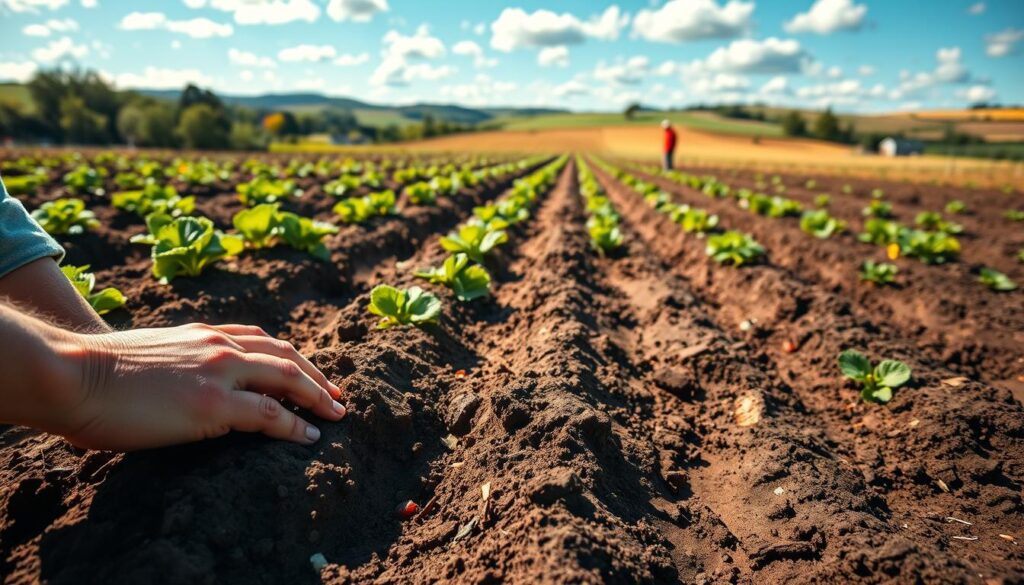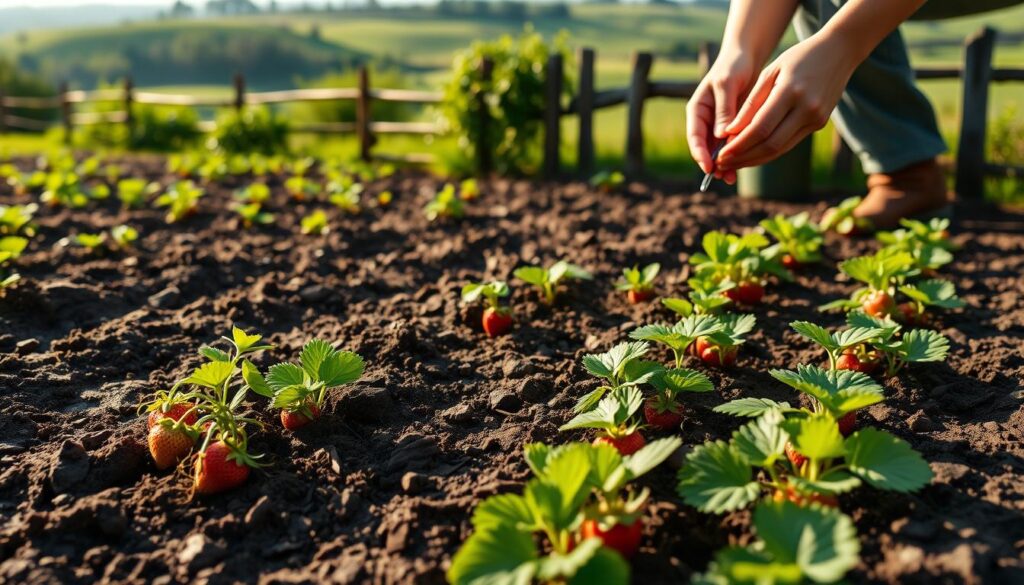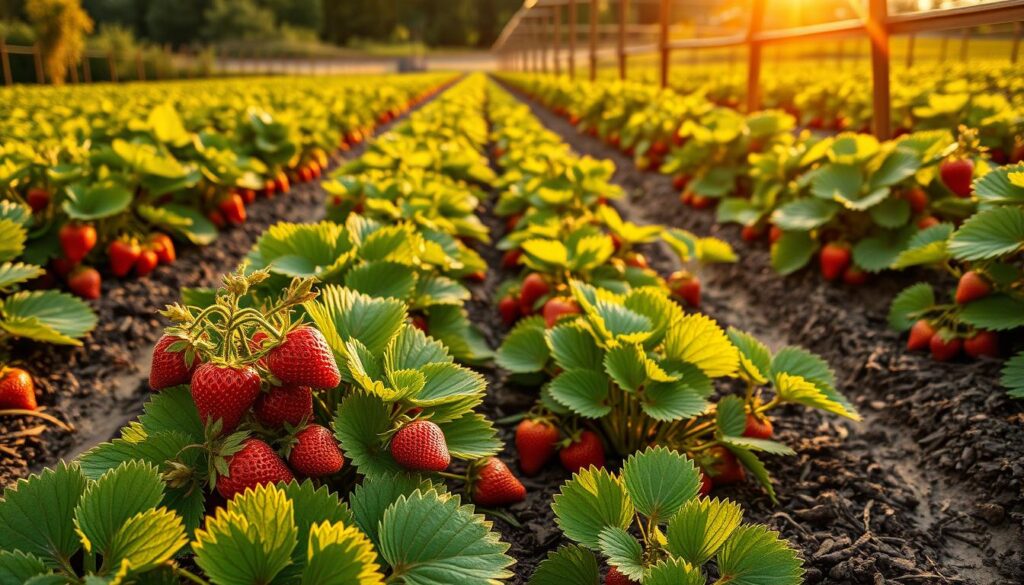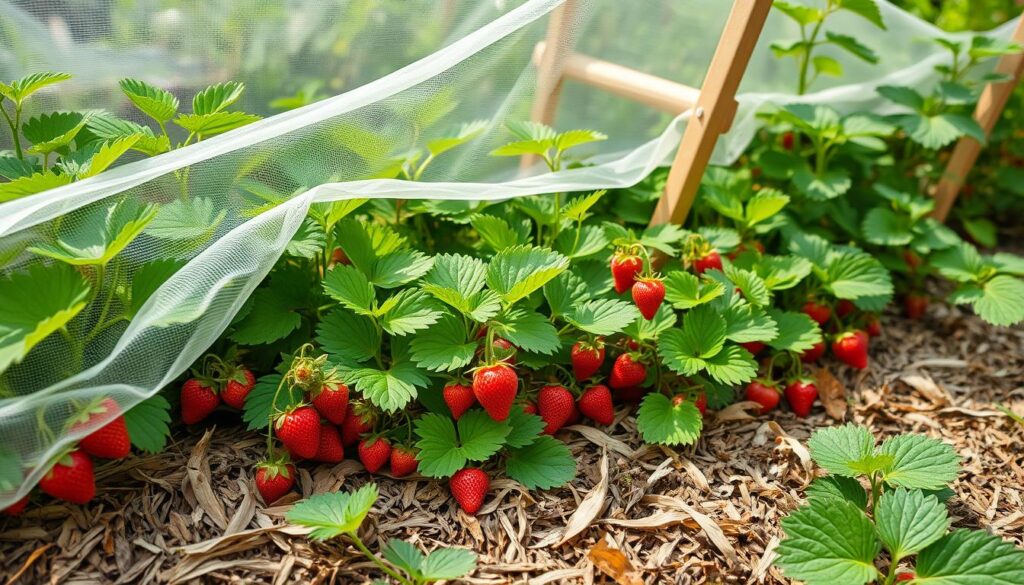Growing strawberries can be very rewarding. You get to enjoy fresh strawberries right in your backyard. But sometimes, we’re let down by a poor harvest.
With the right strawberry growing tips, you can avoid these problems. By using best practices for growing strawberries, you’ll soon have a lot of delicious strawberries.
Whether you’re new to gardening or have experience, we’re here to guide you. We’ll help you start growing strawberries successfully.
Key Takeaways
- Selecting the right strawberry variety is key for a good harvest.
- Good soil is essential for healthy strawberry plants.
- Regular care and maintenance boost yields.
- Knowing common challenges helps you overcome them.
- Using best practices leads to a big harvest.
Understanding Strawberry Plant Varieties
When growing strawberries, knowing the different varieties is key. Strawberry plants vary in type, each with its own traits and growth habits. The right choice depends on your climate, space, and what you like.
June-Bearing Strawberries
June-bearing strawberries produce a big crop in spring. They’re great for those who want lots of strawberries at once. This is perfect for freezing or making preserves.
Popular June-Bearing Cultivars
‘Allstar’, ‘Earliglow’, and ‘Jewel’ are popular June-bearing types. They’re known for their high yields and taste.
Growth Cycle and Yield Expectations
June-bearing strawberries grow runners and produce in the second year. They can give up to 1-2 quarts of strawberries per plant.
Everbearing Strawberries
Everbearing strawberries give smaller crops all season. They’re ideal for those who want strawberries constantly.
Best Everbearing Varieties for Home Gardens
‘Albion’, ‘Evie-2’, and ‘Tristan’ are top picks for home gardens. They’re known for being disease-resistant and yielding a lot.
Day-Neutral Varieties
Day-neutral strawberries are like everbearing but less light-sensitive. They keep producing all season.
Alpine Strawberries
Alpine strawberries are small but pack a lot of flavor. They’re perfect for containers and hanging baskets.
There’s a strawberry variety for every gardener. By knowing the different types, we can pick the best for our climate and space. This ensures a big harvest.
Selecting the Perfect Growing Location
To grow thriving strawberry plants, it’s essential to select a location that meets their specific needs. The right conditions will help ensure a healthy and productive crop.
Sunlight Requirements
Strawberry plants need plenty of sunlight to produce well. Choose a location that gets at least 6 hours of direct sunlight a day. Full sun promotes healthy growth and fruit production.
Soil Conditions
The soil should be well-draining and rich in organic matter. Test your soil to determine its pH level and nutrient content. Most strawberry varieties prefer a slightly acidic to neutral soil pH (around 5.5-7.0).
Space Considerations
When planning your strawberry garden, consider the space needed for the plants to grow. You can choose from various options, including garden beds, containers, and vertical growing systems.
Garden Bed Options
Garden beds are a traditional choice for growing strawberries. They provide good drainage and allow for easy access to the plants.
Container and Vertical Growing Possibilities
Containers and vertical growing systems are ideal for small spaces. They offer flexibility and can be used to create a thriving strawberry crop even in limited areas.
| Growing Method | Space Requirements | Sunlight Needs |
|---|---|---|
| Garden Beds | Moderate to High | Full Sun |
| Containers | Low to Moderate | Full Sun to Partial Shade |
| Vertical Growing | Low | Full Sun |
Preparing Your Soil for Optimal Strawberry Growth
Soil preparation is key for growing strawberries. To get the most from your strawberry harvest, start with the right soil.
Testing Soil pH
Strawberries like a slightly acidic to neutral soil pH, between 5.5 and 7.0. First, test your soil pH. You can use a DIY kit or send a sample to a lab for detailed results.
Adding Organic Matter
Organic matter makes soil better. It improves structure, fertility, and health.
Compost and Manure Applications
Compost and manure are full of nutrients and microbes. Mix 2-4 inches of compost or well-rotted manure into the top 6-8 inches of soil before planting strawberries.
Cover Crops for Soil Improvement
Cover crops like clover or rye can be grown before strawberries. They help suppress weeds, improve soil structure, and increase nutrient content.

Drainage Solutions
Good drainage is key for strawberries, as they don’t like waterlogged soil. To improve drainage, add organic matter or install a French drain if needed.
Raised Bed Preparation
Raised beds offer better drainage and warmer soil, which benefits strawberry plants. To prepare a raised bed, fill it with a mix of topsoil, compost, and perlite or vermiculite for better drainage.
| Soil Preparation Step | Action | Benefit |
|---|---|---|
| Testing Soil pH | Use a testing kit or lab analysis | Ensure optimal pH for strawberries |
| Adding Organic Matter | Mix in compost or manure | Improve soil structure and fertility |
| Drainage Solutions | Add organic matter or install a French drain | Prevent waterlogged soil |
| Raised Bed Preparation | Fill with topsoil, compost, and perlite/vermiculite | Better drainage and warmer soil |
By following these steps, you can create the best environment for your strawberries. This will lead to a more successful and bountiful harvest.
Planting Strawberries: Timing and Techniques
Starting a strawberry garden is exciting. We’ll show you how to plant strawberries right. The right timing and techniques are key for their growth.
Spring vs. Fall Planting
Planting strawberries depends on your area and weather. Spring and fall are the best times to plant. Spring lets strawberries grow before summer heat. Fall gives them a start for the next year.
Proper Spacing Methods
Space is important for strawberry health. There are two main ways: the Matted Row System and the Hill System.
Matted Row System
In this system, plants are 18-24 inches apart. Rows are 3-4 feet apart. This lets runners fill in, making a matted row.
Hill System
For this, plants are 12-18 inches apart in mounds. It’s good for everbearing and day-neutral varieties.

Planting Depth Guidelines
Plant strawberries correctly for their health. The crown should be level with the soil. Avoid burying the crown or exposing the roots.
Container Planting Options
Strawberries can grow in containers too. This is great for small spaces. You can use Strawberry Pots and Towers, or Hanging Baskets and Window Boxes.
Strawberry Pots and Towers
These containers have pockets for plants. They fit many plants in a small area.
Hanging Baskets and Window Boxes
These use vertical space well. Fill them with draining mix. Space plants for air.
Follow these tips for a successful strawberry garden. Whether in the ground or containers, the right care is key.
How to Grow Strawberries Successfully: Essential Care Practices
To get a lot of strawberries, knowing how to care for them is key. Growing strawberries means paying attention to a few important things. These help the plants grow well and produce lots of fruit.
Watering Techniques
Watering strawberries right is very important. They need steady moisture, most when they’re making fruit.
Drip Irrigation Benefits
Drip irrigation sends water straight to the roots. This cuts down on water lost to evaporation and runoff. It also keeps the leaves dry, which helps fight off fungal diseases.
Moisture Monitoring
Check the soil’s moisture often. You can do this by sticking your finger in the soil or using a moisture meter. Change your watering schedule as needed to keep the soil just right.
Fertilization Schedule
Having a good plan for when to fertilize is key for strawberry plants. It helps them grow strong and produce more fruit.
Organic vs. Synthetic Fertilizers
Organic and synthetic fertilizers both have their good points. Organic stuff like compost makes the soil better, while synthetic fertilizers give nutrients fast.
Timing of Applications
Fertilize strawberries in early spring when they start growing again. Also, after you’ve picked all the fruit. Don’t fertilize during the hottest summer months.

Mulching Benefits and Methods
Mulching keeps the soil moist, stops weeds, and keeps the temperature right. It’s a simple trick to help strawberries grow better.
Straw Mulch Application
Put a layer of straw mulch around the plants when the soil warms up in spring. It helps keep moisture in and keeps weeds away.
Plastic Mulch Options
Plastic mulch is also good, but it’s best for raised beds. It warms the soil early and keeps moisture in.
Runner Management
Controlling runners is important for keeping plants healthy and encouraging fruiting. Take off any runners you don’t need to help the plant focus on making fruit.
- Regularly check your strawberry plants for runners.
- Remove weak or unnecessary runners to promote healthy growth.
- Use runners from healthy plants to propagate new strawberry plants.
By following these care tips, you can make your strawberry growing better. This will lead to a more successful and fruitful harvest.
Protecting Your Strawberry Plants
To get the most from your strawberries, protect your plants from harm. This means using good gardening habits and specific actions. Knowing the common problems helps us keep our strawberries healthy and fruitful.
Common Pests and Prevention
Strawberry plants face many pests that hurt their growth. Keeping an eye out and acting fast is key to stopping pests. Common pests include strawberry weevils, aphids, slugs, and snails.
Strawberry Weevils and Aphids
Strawberry weevils and aphids are big pests for strawberry plants. Weevils eat flowers and fruits, while aphids spread diseases. Neem oil or insecticidal soap can control these pests.
Slugs and Snails Control
Slugs and snails damage strawberry plants by eating leaves and fruits. Copper tape or crushed eggshells around plants can keep them away. Also, removing weeds and debris helps reduce their homes.
Disease Identification and Treatment
Strawberry plants get sick from fungi and bacteria. Knowing the disease is key to treating it. Good air flow and removing sick plants stop disease spread.
Fungal Diseases
Fungal diseases like powdery mildew and botrytis need fungicides. Good air flow and removing sick leaves also help.
Bacterial Infections
Bacterial infections are harder to fight. Copper-based bactericides and clean gardening help manage them.
Bird and Animal Deterrents
Birds and animals can harm strawberry plants. Netting or bird-repellent balloons keep them away. Planting pest-repelling plants is also good.
Weather Protection Strategies
Strawberry plants don’t like extreme weather. Row covers or frost blankets protect from frost. Shade during strong sun also helps prevent damage.

Using these protection methods helps us have a great strawberry harvest. Keeping an eye on our plants and acting fast is essential for a bountiful yield.
Seasonal Care for Strawberry Plants
Knowing what strawberry plants need at different times is key to growing them well. Each season brings its own care tasks to keep our plants thriving.
Spring Care Routine
Spring is a big time for strawberry plants as they wake up from their winter sleep. We need to remove winter protection and give them their first fertilizer.
Removing Winter Protection
When it starts to get warmer, we take off the mulch or straw that kept our plants safe. We do this slowly to not shock the plants.
First Fertilizer Application
We give our strawberry plants a balanced fertilizer to help them grow and produce fruit. A 10-10-10 NPK fertilizer is a good choice.

Summer Maintenance
In summer, our strawberry plants need steady water, more so when they’re making fruit. How we water them is very important.
Watering During Hot Weather
We make sure our strawberry plants get about 1 inch of water each week. This can be from rain or us watering them. Mulching helps keep the soil moist.
Fall Preparation
When summer ends, we get our strawberry plants ready for winter. We remove dead leaves and check for any diseases or pests.
Winter Protection
Keeping our strawberry plants safe from harsh winter weather is essential. We cover them with mulch or straw. In really cold places, we use more protection.
Mulching for Cold Climates
A thick layer of organic mulch like straw or pine needles keeps the soil warm and protects the roots from freezing.
Row Covers and Tunnels
In very cold areas, row covers or tunnels add extra protection against wind and frost.
| Season | Care Tasks |
|---|---|
| Spring | Remove winter protection, apply first fertilizer |
| Summer | Maintain consistent moisture, mulch around plants |
| Fall | Remove dead leaves, check for disease or pests |
| Winter | Apply mulch or straw, use row covers or tunnels in cold climates |
By following these seasonal care tips, we can keep our strawberry plants healthy and productive all year.
Harvesting and Storing Your Strawberries
To enjoy the taste of fresh strawberries, timing is key. Picking them at the right time makes them sweet and flavorful.
Identifying Ripe Berries
Ripe strawberries are bright red, firm, and smell sweet. We check by gently touching them; ripe ones come off easily.
Harvesting Techniques
Harvesting strawberries needs care to avoid damage. This protects the fruit and the plant.
Morning Harvest Benefits
Picking strawberries in the morning keeps their flavor and texture better. It’s cooler then, which helps.
Proper Picking Methods
We pick strawberries by twisting the stem off the plant. We leave a small piece of stem attached.
Storage Methods for Maximum Freshness
Storing strawberries right is important to enjoy them longer.
Refrigeration Tips
Strawberries can last up to three days in the fridge. We store them in a covered container to keep humidity.
Freezing and Preserving Options
To store them longer, we freeze strawberries. First, wash, dry, and lay them out to freeze. Then, put them in airtight containers.
Here’s a summary of our strawberry harvesting and storage tips in a handy table:
| Activity | Tips | Benefits |
|---|---|---|
| Identifying Ripe Berries | Check for bright red color and sweet aroma | Ensures sweetness and flavor |
| Harvesting Techniques | Pick in the morning, twist stem gently | Preserves flavor and texture |
| Storage Methods | Refrigerate or freeze, maintain humidity | Extends freshness and shelf life |

Advanced Techniques for Maximum Strawberry Yields
To get the most strawberries, you need to use advanced methods. These go beyond just basic care. They help your strawberry plants grow better and produce more.
Renovation of June-Bearing Plants
Renovating June-bearing strawberry plants is key to keeping them productive. This means removing old leaves and weeds after you pick them. It lets the plants focus on growing new leaves and fruit.
Succession Planting Strategies
Succession planting is a smart way to get more strawberries. By planting new batches every few weeks, you can keep picking strawberries all season long.
Companion Planting Benefits
Companion planting can also help your strawberries grow better. Some plants, when grown with strawberries, can make them grow faster and keep pests away.
Beneficial Companion Plants
Good companions include borage, which attracts bees and butterflies. Nasturtium keeps aphids and whiteflies away from your strawberries.
Plants to Avoid Near Strawberries
It’s also important to know which plants to keep away from strawberries. Plants in the Brassica family can attract pests that harm strawberries.
Extending the Growing Season
There are ways to make strawberries grow longer.
Row Covers and Cold Frames
Row covers and cold frames protect strawberries from frost. This means you can pick strawberries earlier in spring and later in fall.
Greenhouse Cultivation
Greenhouse cultivation gives you full control over your strawberries’ environment. It lets you grow strawberries all year in some places.
| Technique | Description | Benefit |
|---|---|---|
| Renovation | Removing old leaves and weeds | Increased productivity |
| Succession Planting | Planting new batches every few weeks | Continuous harvest |
| Companion Planting | Growing beneficial plants alongside strawberries | Enhanced growth and pest control |
Using these advanced techniques can really boost your strawberry harvest. You’ll get more strawberries and enjoy a better harvest.
Conclusion
We’ve looked at key tips for growing strawberries. This includes knowing the different types and how to get more from your plants. By using these tips, you can have a big harvest of tasty strawberries.
To grow strawberries well, pick the right type and get your soil ready. Make sure to water, fertilize, and mulch them. Also, keep pests and diseases away. Following these steps will help your strawberry patch thrive.
Growing strawberries can be very rewarding. We suggest you try these tips and see the results. Enjoy your gardening journey!
FAQ
What are the different types of strawberry plants, and which one is best for me?
We have several strawberry plant types. June-bearing strawberries give one big crop. Everbearing and day-neutral varieties give smaller crops all season. Alpine strawberries are perfect for containers and produce tiny fruits.
How much sunlight do strawberry plants need?
Strawberry plants need full sun to partial shade. They should get at least 6 hours of direct sunlight daily for best growth and fruit.
What is the ideal soil pH for growing strawberries?
Test your soil pH and aim for 5.5 to 6.5. This range is slightly acidic to neutral, ideal for strawberries.
How often should I water my strawberry plants?
Water strawberry plants regularly. Give them 1-2 inches of water weekly, either from rain or irrigation. Keeping the soil moist, but not soggy, is key for a good harvest.
How do I protect my strawberry plants from pests and diseases?
Use crop rotation, weed removal, and organic pest control. Regularly check your plants and keep your garden clean to prevent problems.
Can I grow strawberries in containers, and what are the benefits?
Yes, you can grow strawberries in containers. This method offers better soil control and drainage. It’s great for small spaces like balconies or patios, allowing you to move plants for better sunlight.
How do I maximize my strawberry yield?
To increase strawberry yields, renovate June-bearing plants, plant in succession, and use companion planting. Row covers, cold frames, or greenhouses can also extend the growing season and increase production.
What are some common mistakes to avoid when growing strawberries?
Avoid overcrowding, poor soil, not enough water, and neglecting runners. Being aware of these mistakes can help you grow a healthy strawberry crop.
How do I store strawberries to keep them fresh?
Store strawberries in a cool, dry place, away from sunlight. For longer storage, refrigerate them. Freezing or dehydrating can also preserve strawberries for longer.